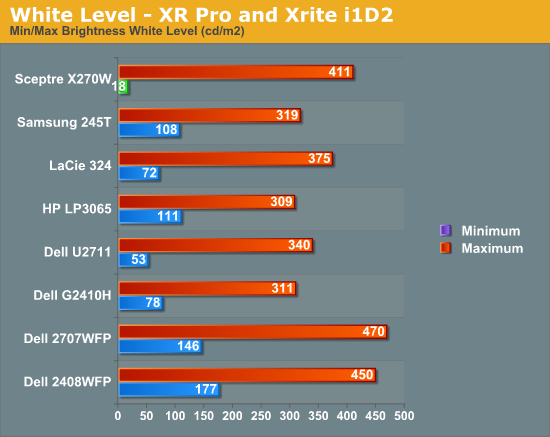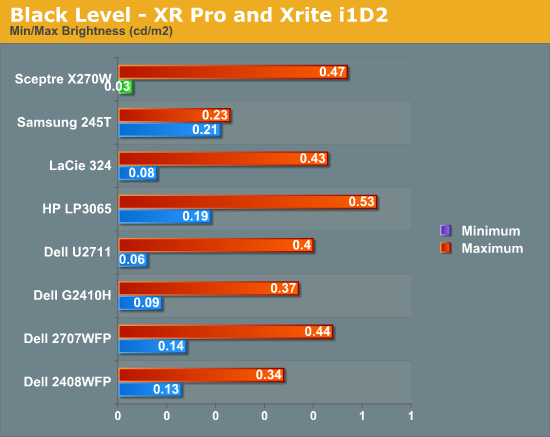Sceptre X270W-1080P Review: A Value 27" That Delivers
by Brian Klug on May 17, 2010 10:22 PM ESTBrightness and Contrast
For brightness, black level, and contrast points, we use the same colorimeter setup described earlier. Specifically, an Xrite i1D2 with ColorEyes Display Pro, and take measurements. Dynamic contrast is always turned off, as this throws off our results. We also let the panels settle in for a half hour at the respective settings before taking any measurements. This is especially important for the X270W since it has a CCFL backlight, and as such there is a discernible warm up period.



Black level is an important metric, since it directly represents the extinction ratio of the crossed polarizers in the TN cells. Remember, when a pixel is desired to be black, the photoelectric crystal in the cell changes linearly polarized light 90 degrees out of phase, so it is blocked by the polarizer. Higher extinction ratios (and thus better crystals and materials) result in lower (better) black levels.
We recommend running monitors at around 200 nits of luminous intensity, just because this is often where some of the best color tracking sits, and it’s enough of a balance to not result in eye stress from looking around the room and having your pupil adjust. I personally am a bit of a light-crazy person and usually crank my displays brightness to the max (I consider 400 nits normal), but again, forget I ever said that. ;-)
The charts show the dynamic range in brightness, and the respective black levels at each brightness. Brightness isn’t quite up to the 400 nits spec, falling short at 293. This is still pretty bright, but not quite as bright as I’m used to. Again, CCFL isn’t the brightest, but it does give better color gamut than WLED.
What we’re really interested in, however, is the contrast ratio. At the extreme, we fall short of 1000:1 with 720 and 646 at both brightness ends. Respectable, but not stellar.
Update: We were able to get the X270W up past the 400 nit specification by changing contrast to 100% in addition to brightness. At those settings, the brightness for white is 411 nits, and blacks are 0.47 nits. We've updated the graphs above to reflect those changes. Contrast also improved slightly, up from 720 to 875.
Obviously, the X270W can go bright if you set the OSD settings appropriately. Things are more washed out than we'd like with contrast at 100%, but you do get all of those cd/m^2 you pay for, and 11 more.










61 Comments
View All Comments
juzz86 - Tuesday, May 18, 2010 - link
Guess it really is a dead-and-goner Brian! I have one of those on my new HP LP3065. It's a single green pixel, only viewable on a solid black background. Bit disheartening on a $1200 monitor, but there ya go.Martimus - Tuesday, May 18, 2010 - link
HP has a 100% dead pixel replacement policy on their more expensive monitors. Plus when you call them, they usually send out a guy to replace the monitor, rather than have you ship it to them.I would at least try calling their customer service, to see if you can get a replacement.
juzz86 - Tuesday, May 18, 2010 - link
I wasn't atually aware of that mate, thankyou very much for filling me in. I'll give them a buzz today and see how I go! Cheers again!AmdInside - Tuesday, May 18, 2010 - link
My vote is for the Asus 27" monitor. I own it and have no complaints.http://www.newegg.com/Product/Product.aspx?Item=N8...
juzz86 - Tuesday, May 18, 2010 - link
A good choice. My sister scored one of these, as I bought it but couldn't 'appreciate' the design on the speaker bar. I love that it has a remote though! Best idea ever.PubicTheHare - Tuesday, May 18, 2010 - link
But I'd like something with fairly accurate color (gaming capable would be nice) and 1920x1200There's something about 1080P that bugs me; it's missing 120 pixels and the omission in favor of marketing it as "1080P" feels like a cheap trick.
Is there a 1920x1200 monitor with decent color reproduction for under $400?
I don't think I've seen any.
juzz86 - Tuesday, May 18, 2010 - link
My recommendation: an older HP or Dell Ultrasharp model. They're usually S-PVA or IPS, and have plenty of features with great colour representation. Samsung are a good bet also. As the market has changed over the past year, you can't look to newer models to provide high-res at high-sizes anymore, without paying a good deal of cash. eBay is your friend, and that's where I'd start. Good luck!Reikon - Tuesday, May 18, 2010 - link
The HP ZR24w is 1920x1200, about $400, and uses an IPS panel.juzz86 - Tuesday, May 18, 2010 - link
Yep, won't do much better than that for $425!Exodite - Tuesday, May 18, 2010 - link
The only reason to get a 27" display would be to get a 2560*1440 resolution, or higher.I'm not going to pay more money for less pixel density, more power usage and more space occupied when I'm essentially getting a less smart-looking Samsung P2250 or P2270.
The only 27" displays on the market with that kind of resolution so far seem to be IPS with a plethora of useless additions such as USB-hubs and such which are geared towards the graphics professional though. Where's the slim and sleek 27" TN panels for the rest of us?
I need the vertical resolution for productivity, 1080p has pretty much killed the reason to ever upgrade from my 1280*1024 set before they burn out completely, and since I only watch movies or play games outside of the text editing and software design side of things TN would be ideal.
And cheaper.
Come on Samsung and LG, I'm putting my faith in you here!